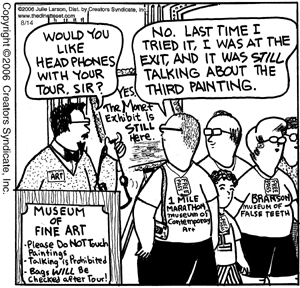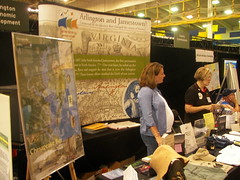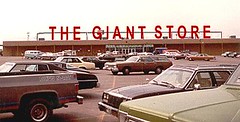Thinking aloud about the meaning of culture
 Dinette Set comic strip.
Dinette Set comic strip.I've been involved in conversations of late about local history and how to present it, how to make it relevant and interesting. There is a deep and ongoing conversation about this in museum circles, in the U.S. and across the world. But in the United Kingdom, this conversation includes the government in a more public fashion.
Locally, too often this conversation gets tied up in issues of race and perspective, sometimes I call this "history as self-affirmation" rather than a focus on "the facts," what this means, how it challenges us, and what can and do we learn from this? We have a bad habit of thinking history as being linear, but with only one true line and perspective. I am trying to get into the habit of thinking of history as more of a mosaic, but still oriented to the "truth" rather than to esteem-building.
In the U.S., we have various agencies that deal with culture, mostly the National Endowment of the Arts and the National Endowment of the Humanities, and historic preservation is addressed by the Department of the Interior under the National Park Service. But there isn't a lot of top-level government involvement in "culture." In fact, we know this is a point of contention within both the legislative and executive branches.
But the general political environment (and even the state of discourse about culture) isn't all that favorable when it comes to culture and history. I have been reading a short essay by the Minister of the Department of Culture, Media & Sport, Tessa J, about history, historic preservation and culture, entitled Better Places to Live: Government, Identity and the Value of the Historic and Built Environment.
In reading this piece, we have to remember that while the history of the U.S. is roughly 400 years old -- this next year Virginia is sponsoring a wide variety of celebrations over the 400th anniversary of the founding of Jamestown--England has 2,000+ years of history. The Magna Carta, the document which "established for the first time a very significant constitutional principle: that the power of the king could be limited by a written grant," is almost 800 years old.

My reaction while reading is that the dominant paradigm with regard to the built environment in that over that past five decades, the development community has moved to a standard of homogeneity, what Kuntsler calls the "Geography of Nowhere," where every place is no place (that is distinctive).
 Image by David Johnson.
Image by David Johnson.While that is the dominant development paradigm, livable places are more than value engineering. Better places are about placemaking and people--the kinds of issues addressed by groups like the Project for Public Spaces and Walkable Communities.
Better Places to Live follows an earlier essay, Government and the Value of Culture, which I have not yet read.
I came across these essays while looking at the publications on the Heritage Lottery Fund website. The HLF is funded through a national lottery, and it provides financial support to various heritage preservation and museum, and cultural affairs efforts across the United Kingdom. The HLF site has a number of publications where they work through such issues as broadening the definition of what heritage means, capturing public value of heritage, and social equity.
(And I came across HLF after listening to an archived talk by Liz Forgan given as part of a two day conference on History and the Public sponsored by the UK Institute of Historical Research.)
_______
The Wallace Foundation has some interesting publications on these issues as they relate to museums. And the National Park Service published National Park Service & Civic Engagement.
Index Keywords: historic-preservation; arts-culture; museums



0 Comments:
Post a Comment
<< Home